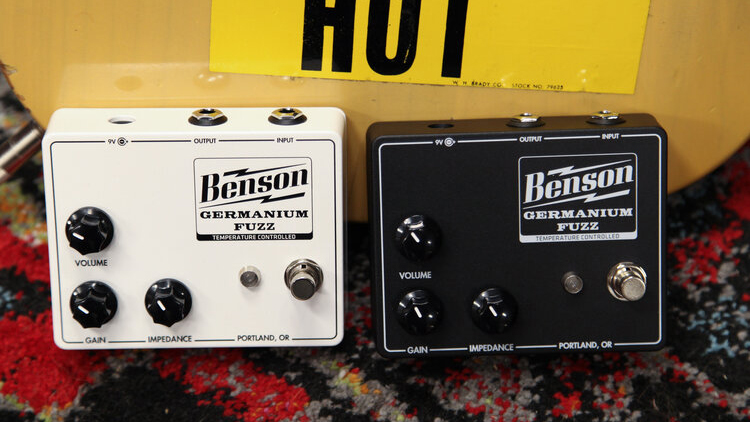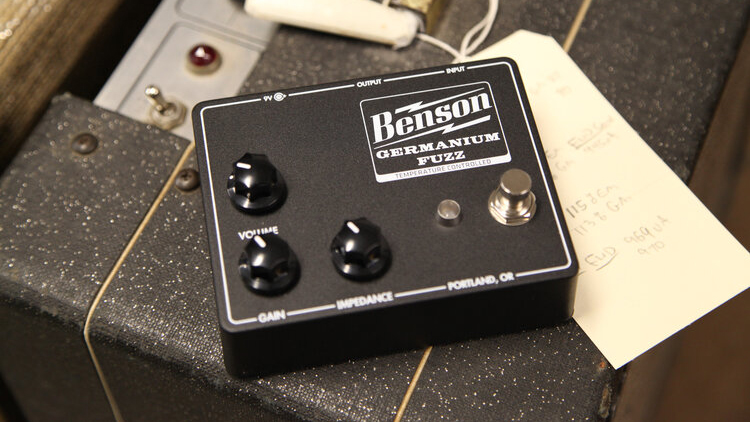There are many fuzz pedals vying for your cash right now, but Benson Amps believe in quality over quantity. Until now, Chris Benson's company only had one effects pedal in their lineup (the acclaimed Preamp) and its new Germanium Fuzz is bringing 21st century innovation to a classic blueprint.
The pedal is designed around two germanium 2N527 or 2N404 Germanium Transistors. Benson has graded them for gain and leakage and matched each pair to sound their best. But where it gets really interesting is the Automatic Thermal Bias Technology Benson is using to regulate them.
The bias of the transistors in the Benson Germanium Fuzz is automatically regulated by a circuit that "gently warms the transistors to a preset operating point using analog components, and ensures a consistent sound, no matter the external temperature."
When the pedal's LED is orange, the transistors are warming up to increase their hFE (transistor gain) and to shift the bias point to the correct voltage (the pedal needs 2-3 minutes after plugging in to sound correct.)
When the LED turns green is means the Germanium Fuzz's warmer is off because the correct bias and hFE have been set. Ben says players should expect the LED to toggle back and forth every so often while the pedal is on to indicate its doing its job.
The idea is the heaters will warm the transistors enough without harming them. The pedal can operate between freezing and 100˚F and Benson has also provided two colour options with temperatures in mind.
The Studio Black is not meant for use in direct sunlight, but the Solar White is all set for it' Benson says there is a 20˚F difference between a black pedal and a white pedal in direct sunlight. Benson have another innovation in this pedal too…
Get the MusicRadar Newsletter
Want all the hottest music and gear news, reviews, deals, features and more, direct to your inbox? Sign up here.

Due to their low impedance, Germanium fuzz pedals can sometimes misbehave in the signal chain with other pedals before them and Benson wanted to address this with a full-time buffer.
It installed a class A buffer in the Germanium Fuzz's output that feeds a passive pickup simulator circuit (an audio transformer set up as an inductor, a resistor, and a capacitor).

After the pickup simulator circuit, there's an Impedance control to simulate rolling down the guitar volume for the crystal clean tones that attract tonehounds to the Germanium pound. You can still achieve a similar effect with your guitar volume control as per tradition.
These innovative approaches enhance the Germanium Fuzz's flexibility compatibility with other pedals possible without losing the goodness. It's not a gnarly gain station; It can be used as a premium clean boost, overdrive and aggressive fuzz – the choice is yours depending on how you set the impedance and gain controls.
The Germanium Fuzz is available now for $299. See Benson Amps for more.

Rob is the Reviews Editor for GuitarWorld.com and MusicRadar guitars, so spends most of his waking hours (and beyond) thinking about and trying the latest gear while making sure our reviews team is giving you thorough and honest tests of it. He's worked for guitar mags and sites as a writer and editor for nearly 20 years but still winces at the thought of restringing anything with a Floyd Rose.
“A fully playable electro-mechanical synth voice that tracks the pitch of your playing in real time”: Gamechanger Audio unveils the Motor Pedal – a real synth pedal with a “multi-modal gas pedal”
“Instead of labouring over a perfect recreation, we decided to make an expanded counterpart”: Chase Bliss teams up with Mike Piera for Analog Man collab based on the legendary King Of Tone









